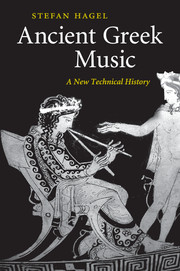Book contents
- Frontmatter
- Contents
- List of diagrams
- List of tables
- List of figures
- List of abbreviations
- Preface
- 1 The evolution of ancient Greek musical notation
- 2 Notation, instruments and the voice
- 3 Notation in the handbooks
- 4 Strings and notes
- 5 Fine tuning
- 6 Going beyond Ptolemy?
- 7 Assisted resonance
- 8 The extant musical documents
- 9 Aulos types and pitches
- 10 Before Aristoxenus
- 11 Synthesis
- Bibliography
- Indices
2 - Notation, instruments and the voice
Published online by Cambridge University Press: 03 May 2010
- Frontmatter
- Contents
- List of diagrams
- List of tables
- List of figures
- List of abbreviations
- Preface
- 1 The evolution of ancient Greek musical notation
- 2 Notation, instruments and the voice
- 3 Notation in the handbooks
- 4 Strings and notes
- 5 Fine tuning
- 6 Going beyond Ptolemy?
- 7 Assisted resonance
- 8 The extant musical documents
- 9 Aulos types and pitches
- 10 Before Aristoxenus
- 11 Synthesis
- Bibliography
- Indices
Summary
BELLERMANN'S SECOND ANONYMUS
From a short late treatise, the second in a collection known as Bellermann's Anonymi, we learn that different selections of keys were associated with different types of music. Lists of tónoi are given for aulos music, for the water–organ (hýdraulis), for citharodic, and finally for ‘orchestic’ music. Although in the text the keys are ordered, as usual, according to pitch, it becomes immediately clear that the single lists are held together by the principle of modulation: they represent contiguous sections of neighbouring keys. Interestingly, of those pairs of tónoi that redouble each other at the octave, sometimes both are mentioned, sometimes only one, omitting the ‘Hyper–’ keys. It seems therefore that in some cases the older, Aristoxenian, system is still influential. But there is never a gap, and it is therefore always possible to proceed over the entire tonal range of one type of music by reiterated application of the simplest types of modulation.
In Diagram 14, the ranges for the various types of music are juxtaposed to the evidence of the fragments. It will be noticed that the least common denominator of all four categories of music consists of the Lydian and Hypolydian scales, the core of the system, which we have also found to be the common ground of the earlier and the later approach.
- Type
- Chapter
- Information
- Ancient Greek MusicA New Technical History, pp. 53 - 96Publisher: Cambridge University PressPrint publication year: 2009



